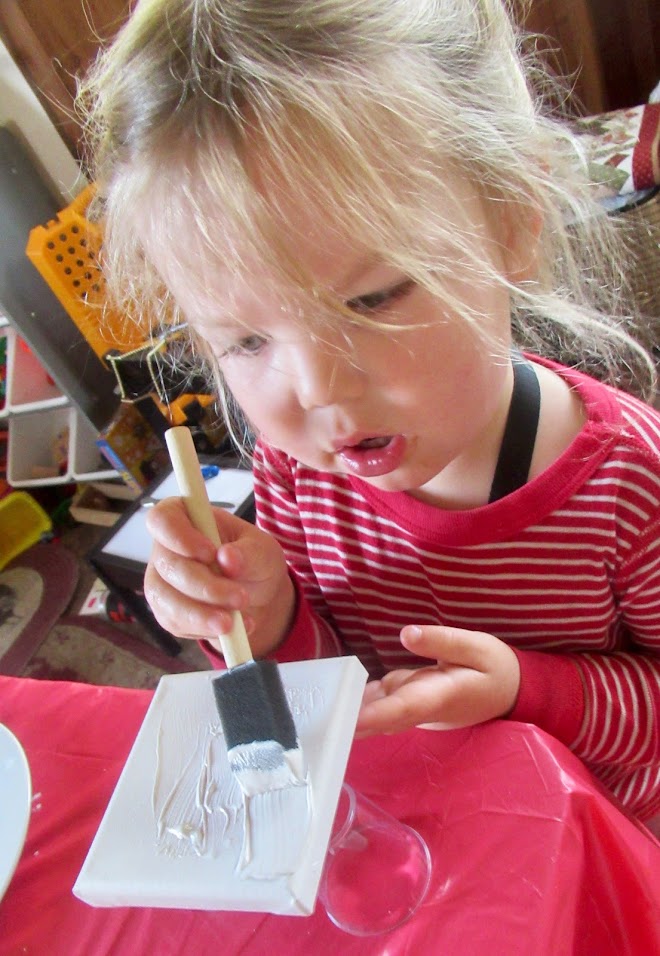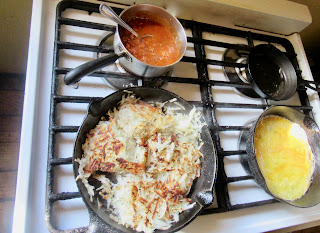We raise a lot of chickens here at HappyDayFarms, thus providing job security for me in the kitchen. One thing about our farm-raised birds, they are almost all in the six-seven pound range, thus allowing me to get two different meals out of a pair of them.
No discussion of preparing chicken for cooking can take place without first talking about the process of brining. Though there are multiple ways to accomplish this, I stick to the simplest one. This requires nothing more than adding three-fourths of a cup of salt to a small sauce pan of boiling water in order to dissolve it, and then adding the mixture to a tuppie filled with my two cut-up chickens, and cold water.
I let the chicken soak in this mixture for four hours, before thoroughly rinsing the chicken and putting it back in the fridge until I am ready for it. In working with raw poultry, I am inordinately careful about cleaning up afterwards, using hot, soapy water to clean all surfaces that came into contact with the chicken or the water in which it was stored. After I am done with the washcloth, I replace it and the hand towel with clean ones.
If I am barbecuing the chicken or oven-roasting it, I add a half-cup of brown sugar to the saucepan of boiling water. And if I am cooking the chicken in a liquid base, like cacciatore or oven roasted chicken in white wine and broth, I skip the brining process as being unnecessary. Brining adds moisture to a properly cooked chicken when it is being prepared in high heat, but the very act of cooking the chicken in a liquid base, ensures that the chicken will be moist.
I have a number of different ways I cook chicken here on-farm, including the aforementioned chicken cacciatore and oven-roasted in a white wine, chicken broth and mustard sauce. I cook a sweet and sour chicken, I barbecue it, I oven-roast it and I make stove-top fried chicken, the way Annie used to make it. I cook chicken teriyaki, I roast them whole, and I do a mean chicken stew.
I make chili chicken, chicken strips, shepherd’s pie with chicken, chicken enchiladas, taquitos, tostadas, burritos, and can make chicken tamales, though I leave that in the capable hands of my son, Ben.
With more than a hundred meat birds on-farm at the moment, I am stoked to know that by summer’s end, we will have freezers well-stocked with chicken for me to cook up for lunches.
Recipes, recipes, who’s got recipes? I have some:
Oven-roasted chicken in white wine
cut-up chicken
one cup white wine
one cup chicken broth
1 tablespoon dijon mustard
One teaspoon salt
3/4 teaspoon black pepper
Fresh rosemary (or 1 teaspoon ground)
Fresh sage (or 1 teaspoon ground)
Fresh oregano (or 1 teaspoon ground)
One large diced onion or comparable amount of shallots, diced
four/five cloves of minced garlic or add garlic to taste
I usually cook two chickens at a time and they are giant, so I will always add to this recipe to accommodate more than just one cut-up chicken or a package of thighs and a package of drumsticks. How much rosemary, sage and oregano you use can be adjusted to taste.
After sauteing the onions and garlic in olive oil, I cut five or six sprigs of rosemary, two large or three smaller stalks of sage and the same for the oregano. I rinse them off, strip the leaves off the stalks, chop them up and add them to the cooked veggies, along with the wine, broth, mustard, salt and pepper. I bring these ingredients to a low boil for just a couple of minutes and pour this mixture over the chicken before it goes into the oven.
I preheat the oven to 400 degrees and roast the chicken for fifty minutes, skin side down, turning it over after 35 minutes, before checking with a thermometer to see that it has reached 165 degrees internally. I serve it with basmati rice, gravy that I make from the sauce in which the chicken cooked, a side dish of cooked greens and a green salad. (At times I will roast it slower, at 350 degrees for a few minutes longer than an hour, before using the thermometer.)
Gluten-free oven-roasted chicken
Preheat oven to 400 degrees
Coat bottom of the roasting pan with olive oil
1 cut-up chicken
1 cup gluten-free flour (I use white rice flour) or 1 cup all-purpose flour
I teaspoon paprika
1 teaspoon salt (omit if chicken is brined)
1/2 teaspoon black pepper
1/2 teaspoon garlic powder
1 teaspoon onion powder
2 eggs
Whisk together flour, salt, pepper, garlic powder, onion powder and paprika. Dip chicken parts in eggs and then thoroughly coat chicken pieces with flour mixture before arranging them in the roasting pan, skin side down.
Bake for 35 minutes, skin side down, before turning the pieces of chicken over and then baking for at least another fifteen minutes. Check to see that the internal temperature is 165 degrees before removing from the oven.
Chicken teriyaki
I have cooked this dish both in the oven and on top of the stove, depending on the temperature outside. Both ways produce excellent results. I tend to brine the chicken for this dish because there is not as much liquid in the roaster/skillet as in the chicken in white wine dish.
Preheat oven to 400 degrees. (I will also cook the chicken at a lower temperature-350 degrees-for a longer time, if it is cold outside and I just want the kitchen to be warm and toasty. I have the flexibility to decide each time how I want to cook it.)
cut-up chicken
1 cup white wine
1 large onion or several shallots, diced
4/5 cloves of minced garlic
1/2 cup honey
1/2 cup Tamari sauce (soy sauce)
1 tablespoon corn starch
1 tablespoon water
1/2 teaspoon ground ginger
salt/black pepper to taste (I start with a teaspoon of salt and 1/2 teaspoon pepper and go from there. It just depends on how much chicken there is.)
Optional: I always add a quart of whole tomatoes but that is because I always have them. They also make the sauce in the roaster more liquid, so less of a reason to brine the chicken.
If I am cooking on top of the stove, I will brown the chicken in a small amount of olive oil before adding the sauce, which I have combined and brought to a boil for a couple of minutes. If I am oven-roasting it, I will lightly coat the roaster with olive oil, arrange the chicken in it and then drizzle the cooking sauce over the pieces of chicken, turning each over so that the entire piece is covered. I will flip the pieces about two-thirds of the way through and make sure I baste the pieces with the sauce. I use a thermometer to see when they get to 165 degrees.
Sweet and sour chicken
cut-up chicken
1 cup white wine
1 pint tomato sauce
I large onion, diced (or several diced shallots)
4/5 cloves of garlic, minced
I tablespoon of corn starch or gluten-free flour (all-purpose flour can be used)
1/2 cup honey
1/4 cup ketchup
1/2 cup apple cider vinegar
1 tablespoon Tamari sauce (soy sauce)
Preparing sweet and sour chicken is identical to cooking chicken teriyaki, both in the oven and on the stove-top.
 |
Stovetop cacciatore with broth
cooking on the back burner. |
Chicken cacciatorecut up chicken
olive oil for sautéing
1 large diced onion
6 cloves of minced garlic
2 bell peppers, diced
2 large carrots, chopped (optional)
mushrooms, chopped and sautéed
8 sprigs of rosemary, chopped (1 teaspoon of ground rosemary)
2 stalks of fresh thyme leaves, minced (1 teaspoon dried thyme)
 |
Thyme, rosemary
and sage |
2 stalks fresh sage leaves, minced (1 teaspoon dried sage)
1 cup red wine1 quart whole tomatoes
1 pint tomato sauce (I use homemade marinara sauce)
1 6 ounce can of tomato paste
1/2 teaspoon red pepper flakes
1 tablespoon maple syrup
salt/pepper to taste (I start with one teaspoon of salt and 3/4 teaspoon of black pepper)
Again, except that I always brown the chicken first for cacciatore, the rest of the preparation is exactly the same as both chicken teriyaki and sweet and sour chicken above.
This recipe for cacciatore is a traditional pasta sauce dish, but I also make a less traditional cacciatore, using chicken broth instead of the pint of marinara and the paste. The chicken tastes pretty much the same but the sauce is thinner and [obviously] less tomatoey. Most folks serve cacciatore over pasta, but in this establishment, I use basmati rice.
 |
| browning chicken for cacciatore |
Stove-top country fried chicken
cut up chicken
2 cups gluten-free flour (I use white rice flour) or multi-purpose flour of any kind
1 tablespoon poultry seasoning *
1 teaspoon paprika or smoked paprika
2 eggs, beaten
oil for frying (I use avocado oil)
As I have mentioned, I almost always cook two chickens at a time, so this recipe has more flour and spices than you would need for a single chicken or packages of thighs/drumsticks. Reduce as needed.
Otherwise, I dip the chicken parts in egg and then coat them thoroughly with the flour mixture. I preheat enough oil in a skillet over a medium fire, so that when I put the chicken in, the oil covers the chicken halfway up, more or less. I cook the chicken skin side for ten minutes, before turning the chicken over. I cover the skillet(s) while cookin it.
I reduce the fire under the chicken to low, and then cook it for twenty more minutes, using a meat thermometer to make sure it is at 165 degrees. If I am not dealing with mammoth chickens, this time frame is always long enough to make sure the chicken is fully cooked.
Chili-chicken
cut up chicken breasts from two chickens
olive oil for sautéing veggies
1 large diced onion
1 large bell pepper, diced
4/5 cloves of garlic
1 diced jalapeno (less if folks are sensitive to spicy food)
2 stalks oregano leaves, minced (or 1 teaspoon dried oregano)
1 teaspoon cumin
1 teaspoon chili powder
1 teaspoon paprika
2 4-ounce cans diced [mild] green chiles
4 cups chicken broth
salt/black pepper ( I start with a teaspoon of salt and 3/4 of a teaspoon of black pepper)
2 cans cannellini beans
1 quart whole tomatoes (32 ounces)
fresh cilantro to taste
corn or gluten-free flour tortillas, preheated, on the side
I boil the whole breasts for thirty minutes, depending on the size, and then cut them up into bite size pieces. You can also shred the chicken if you prefer. I saute the onions, garlic and herbs in olive oil and then add everything else except the chicken and beans, preferring to let the base cook first since the chicken is already cooked, as well as the beans. I prefer to thicken my chili chicken with a quarter-cup of white rice flour, or corn starch, but that is optional.
Once I am happy that everything has blended together, I add the chicken and beans and bring the chili to a boil, before letting it simmer until it is time to eat. Grated Monterey Jack cheese is a great additive and I serve the heated tortillas on the side.
* recipe for poultry seasoning
2 teaspoons dried/crushed sage
1 1/2 teaspoons dried/crushed thyme
1 teaspoon dried/crushed marjoram
3/4 teaspoon dried/crushed rosemary
1/2 teaspoon dried/crushed nutmeg
1/2 teaspoon black pepper
salt to taste (or leave it out and season each dish individually, which is what I like to do)

































